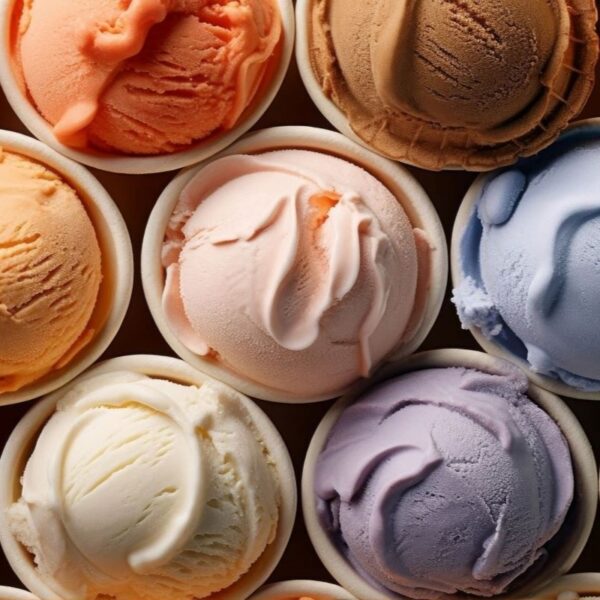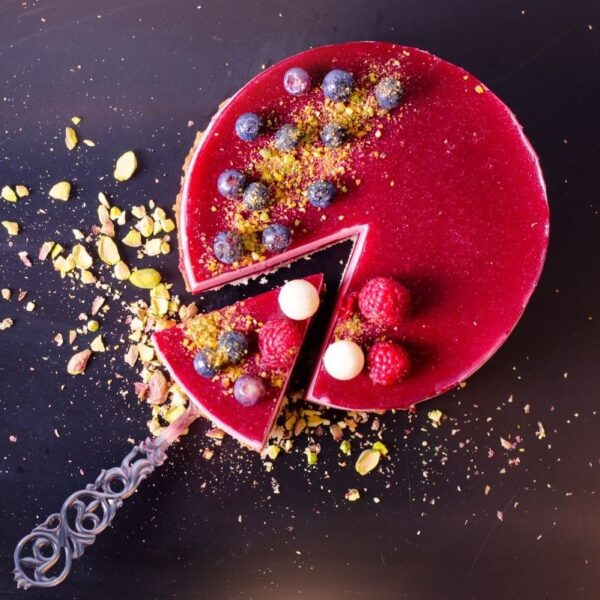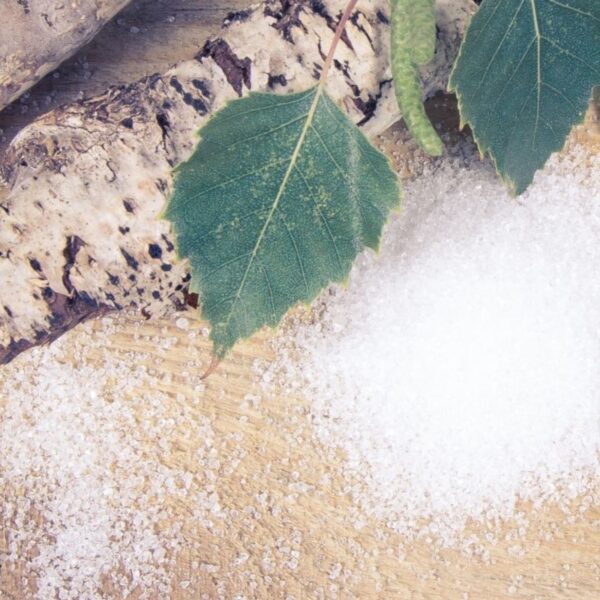Sugar alcohols carry many functional and nutritional benefits — making them an artificial sweetener of choice for many formulators. But which sugar substitute is right for your application? This article analyzes the properties, functionality, and use of maltitol, erythritol, sorbitol, and xylitol in food products.
How are Sugar Alcohols Produced?
Maltitol, erythritol, sorbitol, and xylitol are natural substances containing multiple hydroxyl groups. Though naturally occurring, polyols can be chemically synthesized, hydrogenated, or fermented. You can ferment them by using bacteria, yeast, or fungus. They can also be made synthetically by the catalytic hydrogenation of the sugars. The table below outlines the natural sources of these polyols and the sugar substrates for hydrogenation.
| Polyol | Natural Sources | Substrate for Catalytic Conversion |
|---|---|---|
| Maltitol | Honey, Apple, Grapes, Oats | Maltose |
| Erythritol | Grapes, Pears, Melons, Mushrooms | Glucose |
| Sorbitol | Apple, Pear, Cherry, Berry | Fructose |
| Xylitol | Raspberry, Strawberry, Plum, Carrot, Cauliflower, Mushrooms | Xylose |
Chemical Properties
The following table breaks down the chemical properties of sugar alcohols:
| Property | Maltitol | Erythritol | Xylitol | Sorbitol |
|---|---|---|---|---|
| Molecular Weight (Da) | 344 | 122 | 152 | 101 |
| Melting Point | 150 ℃ | 122 ℃ | 94 ℃ | 101 ℃ |
| Heat of Solution | -78 J/g | -180 J/g | -153 J/g | -111 J/g |
| Physical Form | Powder, Crystals (Granules) & Syrup | Powder, Crystals (Granules) & Syrup | Powder, Crystals (Granules) & Syrup | Powder, Crystals (Granules) & Syrup |
| Solubility (25 ℃) | 175 g/100g Water | 47 g/100g Water | 200 g/100g Water | 235 g/100g Water |
| Viscosity (1% w/v, 25 ℃) | 5.3 cP | 1.3 cP | 2.3 cP | 5.0 cP |
| Calorific Value | 2.1 Cal/g | 0.2 Cal/g | 2.4 Cal/g | 2.6 Cal/g |
| Relative Sweetness w.r.t Sucrose | 80-90 % | 60-70 % | 80-100 % | 50-60 % |
| Glycemic Index | ~35 | ~0 | ~13 | ~9 |
| Shelf Life | 24-36 months | 24-36 months | 24-36 months | 24-36 months |
| GMO Status | GMO & Non-GMO Available | GMO & Non-GMO Available | GMO & Non-GMO Available | GMO & Non-GMO Available |
| Claims *Subject to product claims | Kosher, Halal, Dairy-free, Sugar-free, Non-cariogenic Plant based*, Organic*, Non-GMO*, Natural*, Allergen-free* etc. | Kosher, Halal, Dairy-free, Sugar-free, Non-cariogenic Plant based*, Organic*, Non-GMO*, Natural*, Allergen-free* etc. | Kosher, Halal, Dairy-free, Sugar-free, Non-cariogenic Plant based*, Organic*, Non-GMO*, Natural*, Allergen-free* etc. | Kosher, Halal, Dairy-free, Sugar-free, Non-cariogenic Plant based*, Organic*, Non-GMO*, Natural*, Allergen-free* etc. |
| Storage requirements | Cool, Dry & Dark place < 40 ℃) | Cool, Dry & Dark place < 40 ℃) | Cool, Dry & Dark place < 40 ℃) | Cool, Dry & Dark place < 40 ℃) |
Examples of Food Product Applications
| Sugar Alcohol | Product Examples |
|---|---|
| Maltitol | Ice cream, candy, baked goods, chocolate, beverages, chewing gums |
| Erythritol | Candy, baked goods, jams, jellies, and ice cream |
| Xylitol | Chewing gums, candy, baked goods, jams, jellies, and ice cream, beverages, sports drinks |
| Sorbitol | Candy, beverages, baked goods, jams, jellies, and ice cream |
Functional Applications of Sugar Alcohols in Food Products
Sugar alcohols are widely used in the food industry as functional ingredients due to their unique physical and chemical properties. These substances can act as bulking agents, emulsifiers, stabilizers, humectants, thickeners, and texturizers, providing various benefits to food products.
| Bulking Agent | Add volume to food products without significantly adding calories | Beneficial for creating low-calorie products, such as sugar-free candies and chewing gum, that still have a desirable texture and mouthfeel |
| Emulsifier | Help to stabilize mixtures of two immiscible liquids, such as oil and water | Prevent separation and provide a smooth and creamy texture to foods like mayonnaise, salad dressings, and ice cream |
| Stabilizer | Help to prevent unwanted changes in the texture or consistency of food products over time | Commonly used in baked goods, dairy products, and confections to avoid crystallization and maintain a smooth and consistent texture |
| Thickener & Texturizer | Help to thicken the consistency of food products | Create a smooth and creamy texture in products like yogurt and ice cream — and give products such as jams a firmer texture |
| Humectant | Helps retain moisture in food products | Prevents them from becoming dry and stale over time |
Bulking Agent
One of the primary applications of sugar alcohols in the food industry is as a bulking agent. They add volume to food products without significantly adding calories. Bulking agents are beneficial for creating low-calorie products, such as sugar-free candies and chewing gum, that still have a desirable texture and mouthfeel.
Emulsifier
Sugar alcohols can also act as emulsifiers, which help to stabilize mixtures of two immiscible liquids, such as oil and water. Emulsifiers help to prevent separation and provide a smooth and creamy texture to foods like mayonnaise, salad dressings, and ice cream.
Stabilizer
As stabilizers, sugar alcohols can help to prevent unwanted changes in the texture or consistency of food products over time. They are commonly used in baked goods, dairy products, and confections to avoid crystallization and maintain a smooth and consistent texture.
Humectant
Humectants help retain moisture in food products, preventing them from becoming dry and stale over time.
Thickener & Texturize
In addition to their other functions, sugar alcohols can also act as thickeners and texturizers in food products. They can help create a smooth and creamy texture in products like yogurt and ice cream — and give products such as jams a firmer texture.
See our table below for a breakdown of which sugar alcohols best suit these functions.
Considerations for Sugar Substitution in Food Products
Sugar alcohols are versatile alternatives to table sugar due to their sweetening, bulking, and bodying properties. The table below lists the relative sweetness of sugar alcohols compared to table sugar (sucrose), their calorific value, and their glycemic index.
| Polyol | Calorific value (kcal/g) | Relative Sweetness | Glycemic index |
|---|---|---|---|
| Maltitol | 2.1 Cal/g | 80-90 % | ~35 |
| Erythritol | 0.2 Cal/g | 60-70 % | ~0 |
| Xylitol | 2.4 Cal/g | 80-100% | ~13 |
| Sorbitol | 2.6 Cal/g | 50-60 % | ~9 |
Other Considerations
- Erythritol has the lowest glycemic index of ~0 as it does not cause a hike in the blood sugar level. The calorific value is also very low as over 90 % excreted unchanged in the urine. However, it is comparatively less sweet and requires higher concentrations to achieve the same sweetness levels.
- Xylitol is the sweetest and can be substituted with sugar at a 1:1 ratio. It is relatively high in calories, too, almost half that of sucrose.
- Maltitol has a lower calorific value, but the sweetness is also low compared to xylitol. Hence, the substitution ratio should be higher to obtain a similar sweetness.
Metabolism of Sugar Alcohols in the Human Body
The human body does not assimilate sugar alcohols in the same way as table sugar, like sucrose or glucose. They are partially absorbed in the intestine, and the rest is excreted unchanged in different ways. The unabsorbed sugar alcohol ferments through the colonic microflora in the intestines. About 50% of the energy of fermented polyols is available to the human body.
The table below breaks down how the body metabolizes each of these sugar alcohols.
| Polyol | Absorbed from the small intestine (%) | Excreted (Urine) (%) | Fermented (%) |
|---|---|---|---|
| Xylitol | 25–40 | 0 | 60–75 |
| Sorbitol | 15–20 | 0 | 80–85 |
| Mannitol | 15–20 | 15–20 | 80–85 |
| Maltitol | 45–60 | 0 | 40–55 |
| Sugar alcohol | Metabolism |
|---|---|
| Maltitol | Partially digested in the intestines Non-absorbed part is metabolized by colonic bacteria |
| Erythritol | Fast absorption through the small intestine, not metabolized Over 90% excreted unchanged in the urine The unabsorbed part is fermented in the large intestine by the colonic microorganisms |
| Xylitol | Indirect fermentative degradation of unabsorbed xylitol by intestine bacterial flora Direct metabolism via the glucuronic acid pentose phosphate shunt in the mammalian liver |
| Sorbitol | Partially absorbed in the upper gastrointestinal tract where it undergoes digestion Non-absorbed part is metabolized by colonic bacteria |
Formulation Considerations
Sugar alcohols can provide the functionality and flexibility to develop excellent sugar-free products. Consider the following when using sugar alcohols in food product formulas.
| Polyol | Taste | Aftertaste | Cooling Effect | Touch (Tactile) |
|---|---|---|---|---|
| Maltitol | Sweet | Slight aftertaste | Moderate | Sticky |
| Erythritol | Comparatively mild sweet | Clear aftertaste | High | Powdery |
| Xylitol | Sweet & minty | Mild aftertaste | Moderate | Grainy |
| Sorbitol | Sweet and slightly bitter | Mild aftertaste | High | Grainy |
Cooling Effect
Polyols have a high heat of solution. When the crystalline forms dissolve in the mouth, it creates a pleasant cooling sensation. The cooling effect of polyols varies. Erythritol has the most substantial cooling effect and isomalt the mildest. While this effect may be desirable for peppermint and menthol products, it is unsuitable for others like baked goods or chocolates.
Stability of Sugar Alcohols
| Phase Stability | Stable against crystallization |
| Oxidative Stability | Stable |
| Light Stability | Stable |
| pH Stability | Resistant to hydrolysis at pH>3.5 |
| Temperature Stability | Stable at temperature <160°C |
Effect on the Properties of Food Products
In polyols, a typical relationship between the molecular weight and the functional properties of polyols exists. As the molecular weight of a polyol decreases, osmolality increases, freezing point decreases viscosity decreases, and boiling point increases.
Glass Transition Temperature
Replacing table sugar with sugar alcohol decreases the glass transition temperature and systematically alters caramel samples’ hardness and resilience.
Freezing Point Depression
In frozen products such as frozen desserts, polyols provide body and texture, reducing the freezing point. Sorbitol and erythritol have a higher effect on freezing point than maltitol. Add these sugar alcohols to soften sugar-reduced ice cream and increase its scoopability.
Emulsifying & Texturizing
Sugar alcohols can act as emulsifiers, as they can help to stabilize emulsions. Additionally, they can help to improve the texture and mouthfeel of food and beverages due to their bodying properties.
Viscosity
The viscosity of sugar alcohols increases with heat. The viscosity of erythritol and xylitol is low, yielding a poor bodying effect compared to maltitol.
Masking Bitter Notes
Sugar alcohols like maltitol mask the bitter notes from other ingredients in the food product.
Stability
Sugar alcohols have a low degradation rate of anthocyanins in fruit jam preparations, helping to stabilize them.
Health Benefits and Potential Side Effects of Sugar Alcohols
Potential Side Effects
While sugar alcohols can be helpful for people looking to reduce their sugar intake or manage their blood sugar levels, they can cause digestive issues such as bloating, gas, and diarrhea when consumed in large amounts.
- Consuming over 40–50 g day−1 (adults) and 30 g day−1 of sugar alcohol is likely to cause gastrointestinal discomfort
- Xylitol is more likely to cause digestive issues than other sugar alcohols
- Unlike other sugar alcohols, erythritol is well-tolerated by the body and is not known to cause digestive issues
Health Benefits
Sugar alcohols, on the other hand, render some health benefits.
| Health Benefit | Details |
|---|---|
| Diabetes Management | Erythritol, sorbitol, and xylitol have low glycemic indexes that can help manage blood glucose levels |
| Antioxidant Activity | Erythritol and xylitol have been found to show in-vivo antioxidant activity |
| Digestion & Gut Health | Sorbitol and xylitol are undigested sugar alcohols and can serve as a food source for beneficial bacteria in the gut |
| Cariostatic Effect | Xylitol & sorbitol have proven cariostatic effect |
| Reduced Tooth Decay | Sugar alcohols are non-cariogenic sweetener that does not promote tooth decay |
| Lower Sugar Intake | Foods labeled as “sugar-free,” “reduced-sugar,” or “no added sugar” help consumers to lower carbs and sugar intake |
Regulatory Considerations
Health authorities worldwide allow the usage of maltitol, erythritol, xylitol, and sorbitol, including the World Health Organization, the European Union, and countries such as Australia and Canada. The U.S. Food and Drug Administration (FDA) has classified sugar alcohols as generally considered safe (GRAS) for use in food. The U.S. Food and Drug Administration (FDA) has approved their use in various food products, including baked goods, confectionery, dairy products, preserves, and processed fruits and vegetables.
Identification Numbers
| Maltitol | E 965 |
| Erythritol | E 968 |
| Xylitol | INS 967 |
| Sorbitol | E 420 |
Acceptable Daily Intake
The European Food Safety Authority (EFSA) has established an acceptable daily intake (ADI) for maltitol, erythritol, xylitol, and maltitol of up to 20 milligrams per kilogram of body weight per day (mg/kg bw/day).
Sugar Alcohols Offer Alternatives to Table Sugar With a Range of Functional Food Benefits
While all four sugar alcohols (xylitol, sorbitol, erythritol, and maltitol) are low-calorie sweeteners and can be used as sugar substitutes, they differ in their sweetness levels, glycemic index, and potential side effects. They all represent versatile and valuable sweeteners, providing functional benefits to “low-sugar” food products. Whether as bulking agents, emulsifiers, stabilizers, humectants, thickeners, or texturizers, all these polyols are great options for creating high-quality, stable, and appealing food products that meet the diverse needs and preferences of consumers.
Additional Resources
- MFC – What is ERYTHRITOL?
- Sugar alcohols—their role in the modern world of sweeteners: a review
- Springer – Effect of sweeteners and storage on compositional and sensory properties of blackberry jams
- NIH – Sensory and Physical Effects of Sugar Reduction in a Caramel Coating System
- IFT – Sugar Reduction with Polyols









